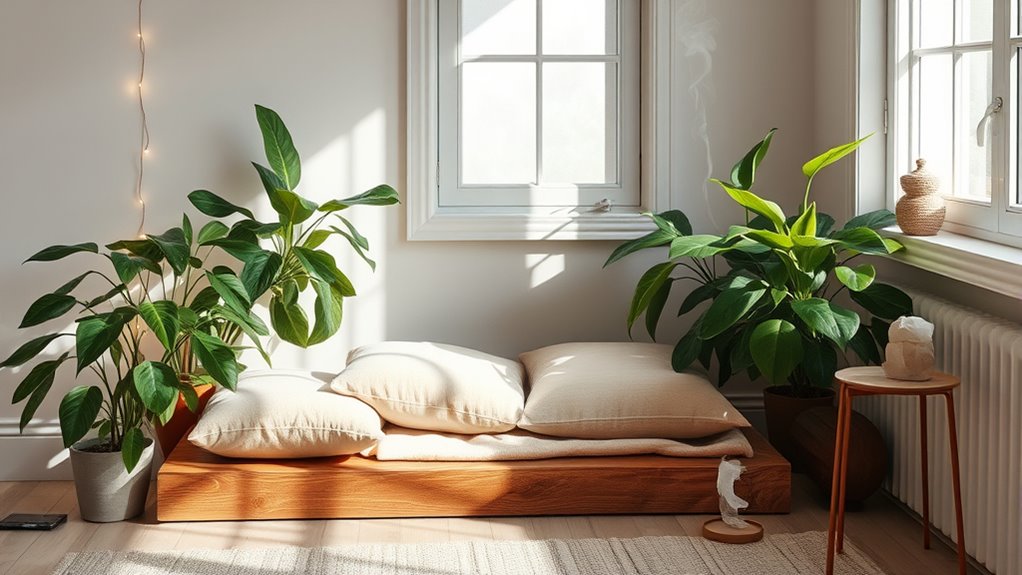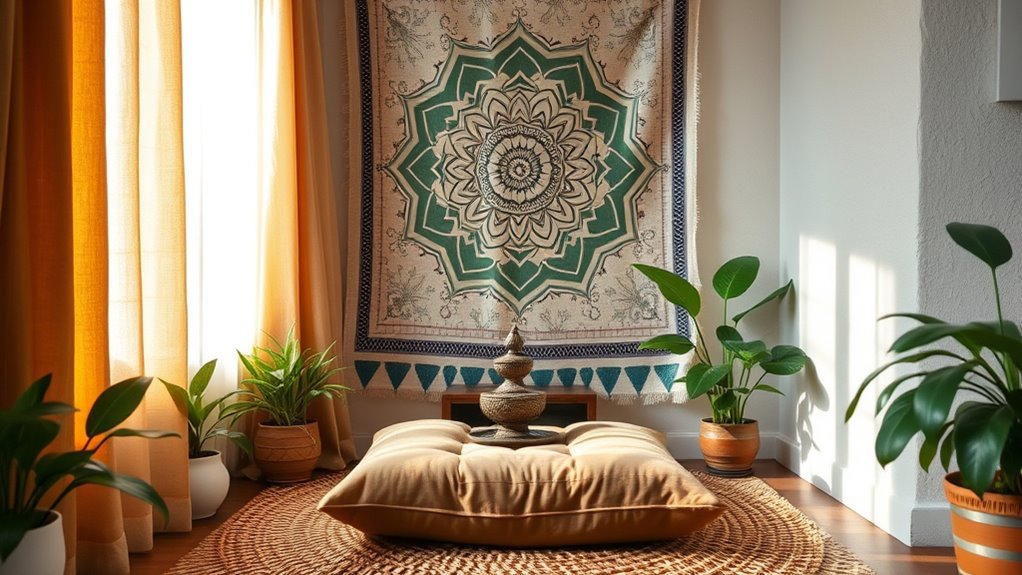To build your own meditation nook for home wellness, start by selecting a quiet, uncluttered corner. Add soft textiles, calming artwork, and natural elements like plants or stones to create a relaxing atmosphere. Use gentle lighting such as dimmable lamps or candles to set the mood. Organize the space with a comfortable seat, a small table, and personal grounding items like crystals. Keep it simple, peaceful, and inviting—if you want tips on designing your perfect sanctuary, keep exploring.
Key Takeaways
- Choose a quiet, uncluttered space near natural light to create a calming environment.
- Incorporate soft textiles, plants, and natural elements to promote tranquility and grounding.
- Use adjustable, warm lighting options like dimmable LEDs or candles to set a peaceful mood.
- Add personal touches such as crystals, inspiring quotes, or small fountains for mindfulness and focus.
- Arrange furniture for comfort and accessibility, ensuring the space supports relaxation and easy meditation practice.

Creating a dedicated meditation nook at home can considerably enhance your wellness routine and provide a peaceful retreat amid daily chaos. When designing this special space, paying attention to decorative accents can make a significant difference. Think about adding elements that evoke calm and inspiration—like soft textiles, meaningful artwork, or natural elements such as stones or plants. These accents don’t need to be elaborate; even simple touches can create a welcoming atmosphere that encourages relaxation. Choose colors that promote tranquility, like muted greens, soft blues, or earthy tones, and incorporate these into your decor to foster a serene environment.
Adding soft textiles, artwork, and natural elements creates a calming, inviting meditation space.
Lighting options play an essential role in shaping the mood of your meditation nook. You want lighting that’s gentle and adjustable, avoiding harsh or overly bright fixtures. Consider installing dimmable lights or soft, warm-toned LED bulbs that mimic natural light. If possible, position your space near a window to take advantage of natural sunlight during the day, which can boost your mood and energy. For evening meditation, use candles or Himalayan salt lamps to create a calming glow. These lighting choices help you transition into a state of mindfulness more easily, reducing stress and promoting deeper relaxation. Additionally, incorporating contrast ratio considerations in your lighting setup can help achieve the desired ambiance and visual comfort.
In addition to decorative accents and lighting, think about the layout of your space. Keep it uncluttered to prevent distractions and foster a sense of openness. Choose a comfortable seat or cushion that supports your posture, and add a small table or shelf for your meditation journal or essential oils. The idea is to create a balance between functionality and aesthetics, ensuring your nook is both inviting and practical.
Personal touches are key to making this space uniquely yours. Incorporate items that inspire or ground you—such as a favorite crystal, a framed quote, or a small fountain for soothing sounds. These elements reinforce your intention and help anchor your practice. When you focus on creating a harmonious environment with thoughtful decorative accents and well-chosen lighting options, you’ll find it easier to slip into a meditative state. Over time, this dedicated corner becomes a sanctuary that supports your mental, emotional, and physical well-being, making your wellness journey more accessible and enjoyable every day.
Frequently Asked Questions
How Much Space Is Needed for a Meditation Nook?
You’ll want at least 3 to 4 square feet for your meditation nook, enough space for a comfortable meditation cushion and some personal touches. Choose calming color schemes to enhance relaxation, and make sure there’s enough room to sit cross-legged comfortably. Keep it simple and clutter-free, so you feel at ease. This setup creates a peaceful retreat without taking up too much space in your home.
What Are the Best Materials for Soundproofing?
You should use soundproof curtains and acoustic panels for effective soundproofing. Soundproof curtains block noise and can be easily installed over windows and doorways, while acoustic panels absorb sound within the space. Combining these materials creates a quieter environment, helping you meditate without distractions. Opt for thick, dense curtains and high-quality panels for the best results, ensuring your meditation nook remains peaceful and serene.
Can I Include Technology in My Meditation Space?
Yes, you can definitely include technology in your meditation space. Think of smart devices like voice-controlled speakers or calming aromatherapy diffusers that enhance your experience. While traditional meditation relies on silence, integrating gentle tech creates a modern oasis that adapts to your needs. These tools help you focus, relax, and deepen your practice, blending tranquility with innovative comfort. Just guarantee they complement your space without overwhelming it.
How Do I Maintain Privacy in Shared Homes?
To maintain privacy in shared homes, you should implement privacy solutions like room dividers, curtains, or soundproofing to create a dedicated meditation space. Use shared space tips such as scheduling quiet times or communicating your needs clearly with housemates. Keep your meditation nook organized and clearly designated, so it feels separate from everyday activity. These strategies help you carve out a peaceful, private environment for your practice.
What Are Budget-Friendly Ways to Decorate?
It’s no coincidence that budget decor and DIY accents transform your space effortlessly. You can find inexpensive decor options at thrift stores or use everyday items for DIY projects that add personality without breaking the bank. Repurpose old furniture, create your own wall art, or decorate with handmade touches. These simple, affordable ideas make your meditation nook cozy and personalized, all while sticking to your budget.
Conclusion
Creating your meditation nook transforms your space into a sanctuary of calm. It’s not just about placing cushions or candles; it’s about carving out a haven where peace resides. Imagine stepping into this retreat whenever life gets hectic—like stepping into your personal oasis. So, why not turn your home into a sanctuary of serenity? After all, your well-being deserves a space as tranquil as your mind can become.








